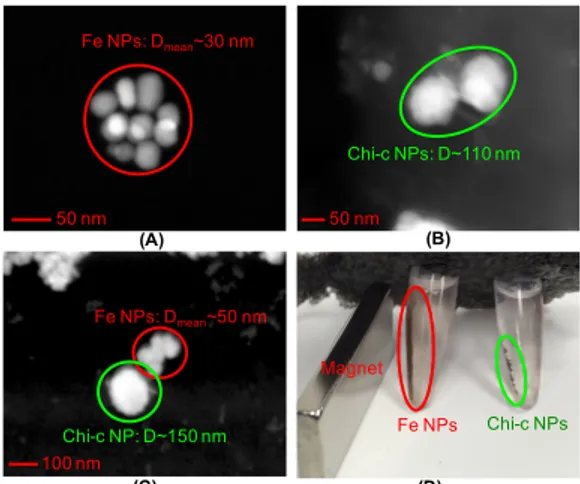3D PRINTED MICROFLUIDIC REACTOR FOR HIGH THROUHPUT
CHITOSAN NANOPARTICLE SYNTHESIS
M. D. Aşık
1, B. Çetin
2, M. Kaplan
1, Y. Erdem
3, N. Sağlam
11
Nanotechnology and Nanomedicine Division, Hacettepe University, Ankara, Turkey
2
Microfluidics & Lab-on-a-chip Research Group, İ.D. Bilkent Uni., Ankara, Turkey and
3
Micro and Nano Integrated Fluids, İ.D. Bilkent Uni., Ankara, Turkey
ABSTRACT
The major bottleneck for the commercialization of nanoparticle related technologies is the mass production of the nanoparticles. One approach to overcome this bottleneck is use of microfluidic devices. In this paper, a 3D printed, high throughput micro-reactor that is capable of synthesizing both chitosan and chitosan coated iron oxide nanoparticles is presented.
KEYWORDS: Microfluidics, NP reactor, chitosan, magnetic chitosan INTRODUCTION
Microfluidic reactors (micro-reactors) are the promising way to synthesize monodisperse nanoparticles as they can provide a very controlled environment for chemicals and can perform precise mixing at controlled concentrations. Chitosan is one of the most suitable materials that can be used in drug delivery due to its biocompatibility, low toxicity, small size, biodegradability and stability1. On the other hand, chitosan coated iron-oxide nanoparticles can be used for targeted drug delivery; where drug embedded in chitosan can be directed to the affected area by an external magnetic field. Composite chitosan nanoparticles had been made by batch-wise synthesis method2. In these studies the obtained particles were polydisperse with different sizes and shapes. The synthesis of chitosan nanoparticles for drug delivery by using a micro-reactor was demonstrated3 using a continuous flow reactor fabricated from polydimethlysiloxane (PDMS) and achieved monodisperse sizes. Later higher throughput micro-reactors were developed4 where they synthesized various polymeric nanoparticles. In this work, we present a 3D printed, high throughput micro-reactor with a simple, robust connectors which can be easily use highly parallel manner.
EXPERIMENTAL
The fabrication of the mold is performed using 3D printer (3D systems, projet 3500 HDmax). The microfluidic reactor has two inlets and one exit. The chitosan and TPP solution are fed into the reactor through the inlet and the NP solution is collected from the outlet. To enhance the mixing inside the reactor, a hurdle structure is designed within the channel5. Two set of experiments to synthesize
chitosan nanoparticle and chitosan-coated (Chi-c) Fe-NPs (magnetic chitosan NPs). In the first set, effect of the volumetric flow rate and the pH is investigated. In the second set, with the optimum values for the volumetric flow rate (120 / 120 ml/h) and pH (4.5), TPP solution together with Fe NPs is fed into the reactor. The products are analyzed by a dynamic light scattering (DLS) (Malvern, Zeta-Sizer) and TEM imaging.
Inlet #1 Inlet #2 Outlet 0 10 20 30 40 50 60 70 80 90 100 1000 10000 In te n sit y Size [nm] C: 80, TPP: 120 C: 40, TPP: 120 C: 120, TPP: 80 C: 120, TPP: 40 C:120, TPP:120 C: 40, TPP: 120 C: 80, TPP: 120 C: 120, TPP: 80 C: 120, TPP: 40 C: 120, TPP: 120 0 5 10 15 20 25 30 35 40 45 50 100 1000 10000 In te n sit y Size [nm] pH=4.0 pH=4.4 pH=4.5 pH=4.6 pH=4.8 pH=5.0 pH = 4.4 pH = 4.0 pH = 4.5 pH = 4.6 pH = 4.8 pH = 4.8 (A) (B) (C)
100 nm Chi-c NP: D~150 nm Fe NPs: Dmean~50 nm 50 nm Chi-c NPs: D~110 nm 50 nm Fe NPs: Dmean~30 nm Magnet Fe NPs Chi-c NPs (A) (B) (C) (D)
Figure 2: TEM image of the chitosan coated NPs.
RESULTS AND DISCUSSION
Use of 3D printing instead of mold fabrication resulted in higher precision leading to better mixing and highly monodisperse nanoparticles. The effect of pH and volumetric flow rates was investigated, as shown in figure 1. Optimum values for nanoparticle production was 120/120 ml/h and pH=4.5. While, the change of flow rates affects diameter of the nanoparticles, the change of the pH affects the size distribution. Tuning of pH and flow rates could make mass production of nanoparticle in desired size and size distribution possible. The TEM images shows that iron nanoparticles were coated with chitosan which lead to magnetic chitosan nanoparticles. The observed size of nanoparticles in TEM images are smaller than the calculated size in DLS due to shrinkage of nanoparticles during drying (Figure 2). Moreover, TEM images indicates that, Fe nanoparticles were coated with chitosan, and under magnetic filed Fe-NPs and Chi-c NPs have a similar tendency to move towards the magnet.
CONCLUSION
Commercialization of nanoparticle related technologies depends on mass production. Especially, bio-polymeric nanoparticles, such as chitosan could have a great role in medicine if higher production rates can be achieved. This study focuses on smart and easy technology based on 3D printing to pro-duce chitosan nanoparticles with high throughput. The results indicates that with 4 parallel chips it is possible to produce nanoparticles at rates up to 0.96 L/h. Future studies should include drug loading during production to make nanoparticles available for nanomedicine research.
REFERENCES
[1] P. Couvreur, “Nanoparticles in drug delivery,” Adv. Drug Deliver. Rev., vol. 65, pp. 21-23, 2013. [2] G. Ünsoy, S. Yalcin et. al., “Synthesis optimization and characterization of chitosan-coated iron
oxide nanoparticles produced for biomedical applications”, J. Nanopart. Res., 14, 964, 2012. [3] F. S. Majedi, M. M. Hasani-Sadrabadi, J. J. VanDersarl et. al. “On-chip fabrication of
pclitaxel-loaded chitosan nanoparticles for cancer therapeutics”, Adv. Func. Mater.,24, 432-441, 2014. [4] Q. Feng, L. Zhang, C. Liu et. al., “Microfluidic based high throughput synthesis of lipid-polymer
hybrid nanoparticles with tunable diameters,” Biomicrofluidics, 9, 052604, 2015.
[5] B. Cetin, M. D. Asik, S. Taze, “Design and fabrication of a microfluidic device for synthesis of chitosan nanoparticles,” ASME J. Nanotech. Eng. Medicine, 4, 031004, 2013.
CONTACT
